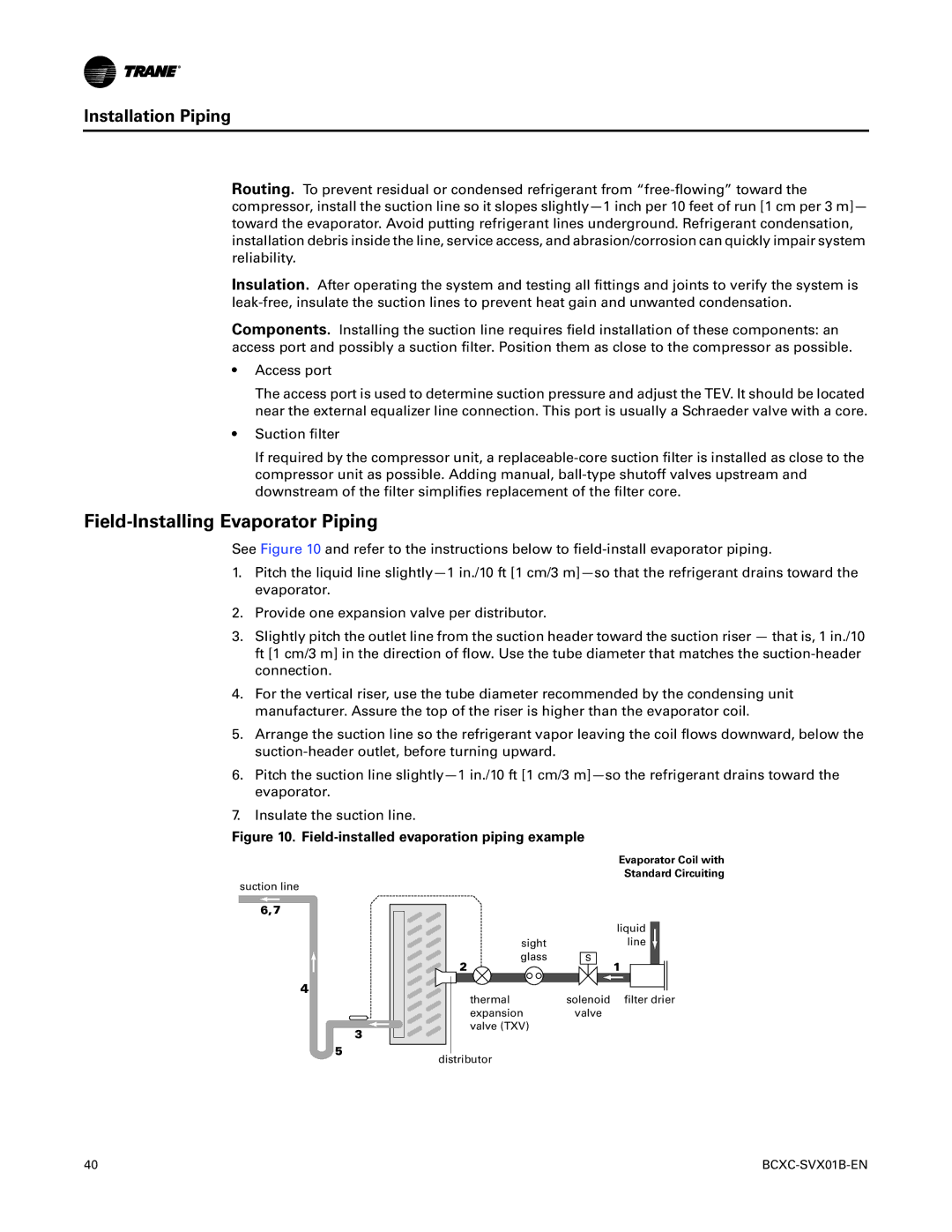Blower Coil Air Handler
April
Environmental Concerns
Refrigerant warning information
Responsible Refrigerant Practices
Hazard of Explosion and Deadly Gases
About This Manual
Trademarks
Table of Contents
BCXC-SVX01B-EN
Digit 16 Motor Horsepower
Digits 1, 2, 3, 4 Unit Model
Digits 5, 6, 7 Unit Size
Digit 8 Unit Voltage
Model Number Description
General Information
Blower Coil General Information
General Information
Receiving and Handling
Pre-Installation
Jobsite Storage Recommendations
Installation Preparation
Service Access
Pre-Installation
Unit size Dimension a
Unit Handling Procedure
Rigging and Handling
Improper Unit Lift
Unit Location Recommendations
Pre-Installation Checklist
Skid Removal
Dimensions and Weights
Horizontal blower coil dimensions in. and weights lb
Unit Size RH LH Weight
Horizontal Blower Coil
Dimensions and Weights
Vertical blower coil dimensions in. and weights lb
Unit Size Weight
Vertical Blower Coil
Angle Filter and Mixing Box
Angle filter and mixing box dimensions in. and weights lb
Unit size
Bottom or Top Access Filter Box
AIR Flow Filter Filter Access Panel
Electric heat dimensions in. and weights lb
Electric Heat
Steam coil box dimensions in. and weights lb
Steam Coil
Coil Connections, NPT
Supply Return
Coil Connections
Hydronic coil connection sizes, OD
DX coil connection sizes, OD
Steam coil connection sizes, female connection, NPT
Piping Packages
Basic Piping
Dimensions and Weights Deluxe Piping
Piping Nominal
Actual size
Installation Controls
Installing Wall Mounted Controls
Zone Sensor Installation
Wiring Instructions
Communication Wiring
Installation Controls
Service Communication Wiring
Zone Sensors Without Interconnecting Wiring
Tracer Summit Communication Wiring
Installation Electrical
Installation Electrical
Zone sensor maximum wiring distances, ft m
Wire size range Max. wiring distance
Electrical Grounding Restrictions Hazardous Voltage
Available electric heat, min-max kW
Useful Formulas
Unit size Voltage
Motor electrical data
220/50/1
240/50/1
190/50/3
380/50/3
Installation Mechanical
Installing the Unit
Bchc Installation Procedure
Horizontal Units, Model Bchc
Installation Mechanical
Vertical Units, Model Bcvc
Heating Coil Option
Mixing Box Option
Linkage Installation Procedure
Mixing Box Installation Procedure
Condensate Drain Connections
Recommended drain trap installation for draw-through units
Duct Connections
Installation Piping
Water Coil Connections
Potential coil-freeze condition
Refrigerant Coil Piping
Valve Damage
Installation Piping
Suction Line
Field-Installing Evaporator Piping
Field-installed evaporation piping example
Steam Piping
Coil Condensate
General
Steam Coils
Type NS steam coils, horizontal tubes for horizontal airflow
Control Options
Controls Interface
Tracer Controllers
Rover Service Software
Controls Interface
Tracer controller input/output summary
Tracer controller ZN010 ZN510 ZN520
End Device Option Availability
Tracer controller function summary
Tracer Control Device ZN010 Tracer ZN510 Tracer ZN520
Pre-Start Checklist
Pre-Start
Receiving
Unit Location
Pre-Start Component Overview
Ductwork
Unit Piping
Electrical
Sequence of Operation
Start-Up
Tracer ZN Controller Sequence of Operation
Occupied Mode
Unoccupied Mode
Sensor type Sensor position Unit occupancy mode
Start-Up
Cooling Operation
Occupied Standby Mode Tracer ZN510 or ZN520 only
Occupied Bypass Mode, Tracer ZN510 or ZN520 Only
Start-Up Economizer Cooling Tracer ZN520 Only
DX Cooling Tracer ZN520 only
Discharge Air Tempering Tracer ZN520 Only
Heating Operation
Fan Mode Operation Rotating Components
Tracer ZN520 fan configuration
Auto fan operation Fan speed default
Fan sequence of operation
Fan Speed Switch
Tracer ZN010 and ZN510
Tracer ZN520
Continuous Fan Operation
Fan Off Delay
Fan mode operation, Tracer ZN010 and ZN510
Start-Up Fan Cycling Operation
Fan Start on High Speed
Entering Water Temperature Sampling Function
Local fan switch enabled
Two- and Four-Pipe Changeover Operation
Fan operation in heating and cooling modes
Unit mode as related to water temperature
Unit type EWT sensor required? Coil water temperature
Electric Heat Operation
Economizer Damper Tracer ZN520 Only
BIP1 Low Temperature Detection Option
Tracer Dehumidification Tracer ZN520 Only
Data Sharing Tracer ZN510 or ZN520 Only
Binary Inputs
Binary input configurations
BIP2 Condensate Overflow Detection Option
BIP3 Occupancy Sensor
BIP4 Fan Status ZN520 Only
Analog Inputs
Binary Outputs
Analog inputs
Analog input Terminal Function Range ZN010 ZN510 ZN520
Space Temperature Measurement
Binary output configuration
Zone sensor wiring connections
Zone Sensor
Fan Mode Switch
External Setpoint Adjustment
Fan Switch
Local Setpoint
On/Cancel Buttons
Communication Jack
Maintenance
Maintenance Procedures
Maintenance
Fan Assembly Set Screws
Fan Belt Tension
Torque in.-lb Ft-lb
Belt tension
BCBH/BCVC valve package waterflow limits
Hydronic coil data
BCHC/BCVC coil general data
Row coil
Steam coil data
Unit Motor Motor sheave Fan sheave Belt
Drive data
1750 1450 Size Watts Browning Trane 60 Hz 50 Hz
Coil Maintenance
Potential unit damage from coil cleaners
Inspecting and Cleaning Coils
Steam, Hot Water, and Cooling Coil Cleaning Procedure
Periodic Maintenance Checklists
Rotating parts
Maintenance
Troubleshooting
Diagnostics
LED Activity
Manual Output Test Procedure
Diagnostics
Manual Output Test
Diagnostics
Translating Multiple Diagnostics
Tracer ZN520 test sequence
Fan Cool output a Heat output Damper Steps J1-1, J1-3
Resetting Diagnostics
Automatic Reset by the Controller
Diagnostics Manual Output Test
Cycling Power
Rover Service Tool
Diagnostic Reset Tracer ZN510 or ZN520 Only
Tracer ZN010 and ZN510 controller diagnostics
Tracer ZN520 diagnostics
Diagnostic Latching Fan Valves Electric heat Damper
Diagnostic Fan Other outputsa
Common Diagnostics
Fan outputs do not energize
Valves stay closed
Probably cause Explanation
Electric heat not operating
Valves stay open
Fresh air damper stays closed
Fresh air damper stays open
DX or electric outputs do not energize
Wiring Diagrams
Two-Pipe Bcxc with Tracer ZN510
Wiring Diagrams
Four-Pipe Bcxc with Tracer ZN510
Four-Pipe Bcxc with Tracer ZN510
Two-Pipe Bcxc with Tracer ZN520
Four-Pipe Bcxc with Tracer ZN520
Four-Pipe Bcxc with Tracer ZN520
Four-Pipe Bcxc with Tracer ZN520
Four-Pipe Bcxc with Control Interface
Four-Pipe Bcxc with Control Interface
Field Installed Device
Bcxc with DX Coil and Tracer ZN520
Bcxc with DX Coil, Hydronic Heating, and Tracer ZN520
BCXC-SVX01B-EN

